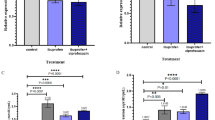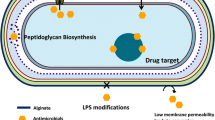Abstract
Biofilm formation is an important factor in disease development by Pseudomonas aeruginosa. Similar to many bacterial species, biofilm formation in P. aeruginosa is regulated by the bacterial quorum sensing system. The pel genes are responsible for the synthesis of a glucose-rich polysaccharide that is associated with biofilm initiation and maturation. The antibiofilm potential of ibuprofen has been reported; however, the effect of the drug on the expression of the genes involved with biofilm formation has rarely been described. In this work, the effect of ibuprofen on the biofilm formation and expression of pelD and pelF genes among pathogenic P. aeruginosa strains was investigated. Multiple drug-resistant P. aeruginosa strains were treated with ibuprofen at ½ MIC concentration and their biofilm formation and expression of pelD and pelF genes was determined using the crystal violet and real-time PCR assays, respectively. The results showed that the ibuprofen at 1024 µg/mL significantly reduced biofilm formation of P. aeruginosa strains by 52–77%, compared with the controls. In addition, treating the bacteria with ibuprofen decreased the expression of pelD and pelF genes to 0.56 and 0.69 folds, respectively. We hypothesized that the attenuation of the pel genes could be associated with the reduction of bacterial QS autoinducers, which in turn reduced cellular c-di-GMP level. This work suggests that ibuprofen is a potent antibiofilm drug that could be used to enhance bacterial susceptibility to antimicrobials through the inhibition of biofilm formation.




Similar content being viewed by others

Data availaibility statement
The majority of the data used to support the findings of this study were included in the manuscript. In addition, the additional data are available from the corresponding author upon reasonable request.
Abbreviations
- EPS:
-
Extracellular polymeric substances
- MIC:
-
Minimum inhibitory concentration
- NSAIDs:
-
Non-steroidal anti-inflammatory drugs
- QS:
-
Quorum sensing
References
Abdolhosseini M, Zamani H, Salehzadeh A (2019) Synergistic antimicrobial potential of ciprofloxacin with silver nanoparticles conjugated to thiosemicarbazide against ciprofloxacin resistant Pseudomonas aeruginosa by attenuation of MexA-B efflux pump genes. Biologia 74(9):1191–1196. https://doi.org/10.2478/s11756-019-00269-0
Baraquet C, Murakami K, Parsek MR, Harwood CS (2012) The FleQ protein from Pseudomonas aeruginosa functions as both a repressor and an activator to control gene expression from the pel operon promoter in response to c-di-GMP. Nucleic Acids Res 40(15):7207–7218. https://doi.org/10.1093/nar/gks384
Brindhadevi K, LewisOscar F, Mylonakis E, Shanmugam S, Verma TN, Pugazhendhi A (2020) Biofilm and Quorum sensing mediated pathogenicity in Pseudomonas aeruginosa. Process Biochem 96:49–57. https://doi.org/10.1016/j.procbio.2020.06.001
(2017) CLSI: performance standards for antimicrobial susceptibility testing; 27th ed. clsi supplement m100. wayne, pa: clinical and laboratory standards institute
Colvin KM, Gordon VD, Murakami K, Borlee BR, Wozniak DJ, Wong GC, Parsek MR (2011) The pel polysaccharide can serve a structural and protective role in the biofilm matrix of Pseudomonas aeruginosa. PLoS Pathog 7(1):e1001264. https://doi.org/10.1371/journal.ppat.1001264
Crouzet M, Le Senechal C, Brözel VS, Costaglioli P, Barthe C, Bonneu M, Garbay B, Vilain S (2014) Exploring early steps in biofilm formation: set-up of an experimental system for molecular studies. BMC Microbiol 14(1):1–12. https://doi.org/10.1186/s12866-014-0253-z
Dai L, Wu TQ, Xiong YS, Ni HB, Ding Y, Zhang WC, Chu SP, Ju SQ, Yu J (2019) Ibuprofen-mediated potential inhibition of biofilm development and quorum sensing in Pseudomonas aeruginosa. Life Sci 237:116947. https://doi.org/10.1016/j.lfs.2019.116947
Friedman L, Kolter R (2004) Genes involved in matrix formation in Pseudomonas aeruginosa PA14 biofilms. Mol Microbiol 51(3):675–690. https://doi.org/10.1046/j.1365-2958.2003.03877.x
Ha DG, O’Toole GA (2015) c-di-GMP and its effects on biofilm formation and dispersion: a Pseudomonas aeruginosa review. Microbiol Spectr 3(2):3–2. https://doi.org/10.1128/microbiolspec.MB-0003-2014
Lee VT, Matewish JM, Kessler JL, Hyodo M, Hayakawa Y, Lory S (2007) A cyclic-di-GMP receptor required for bacterial exopolysaccharide production. Mol Microbiol 65(6):1474–1484. https://doi.org/10.1111/j.1365-2958.2007.05879.x
Mangoudehi HT, Zamani H, Shahangian SS, Mirzanejad L (2020) Effect of curcumin on the expression of ahyI/R quorum sensing genes and some associated phenotypes in pathogenic Aeromonas hydrophila fish isolates. World J Microbiol Biotechnol 36(5):1–9. https://doi.org/10.1007/s11274-020-02846-x
Naves P, Del Prado G, Huelves L, Rodriguez-Cerrato V, Ruiz V, Ponte MC, Soriano F (2010) Effects of human serum albumin, ibuprofen and N-acetyl-l-cysteine against biofilm formation by pathogenic Escherichia coli strains. J Hosp Infect 76(2):165–170. https://doi.org/10.1016/j.jhin.2010.05.011
Obad J, Šušković J, Kos B (2015) Antimicrobial activity of ibuprofen: new perspectives on an “Old” non-antibiotic drug. Eur J Pharm Sci 71:93–98. https://doi.org/10.1016/j.ejps.2015.02.011
Pfaffl MW (2001) A new mathematical model for relative quantification in real-time RT-PCR. Nucleic Acids Res 29:2002–2007. https://doi.org/10.1093/nar/29.9.e45
Reichhardt C, Jacobs HM, Matwichuk M, Wong C, Wozniak DJ, Parsek MR (2020) The versatile Pseudomonas aeruginosa biofilm matrix protein CdrA promotes aggregation through different extracellular exopolysaccharide interactions. J Bacteriol 202(19):e00216-e220. https://doi.org/10.1128/JB.00216-20
Reśliński A, Dąbrowiecki S, Głowacka K (2015) The impact of diclofenac and ibuprofen on biofilm formation on the surface of polypropylene mesh. Hernia 19(2):179–185. https://doi.org/10.1007/s10029-013-1200-x
Sakuragi Y, Kolter R (2007) Quorum-sensing regulation of the biofilm matrix genes (pel) of Pseudomonas aeruginosa. J Bacteriol 189(14):5383–5386. https://doi.org/10.1128/JB.00137-07
Salehzadeh A, Zamani H, Langeroudi MK, Mirzaie A (2016) Molecular typing of nosocomial Staphylococcus aureus strains associated to biofilm based on the coagulase and protein A gene polymorphisms. Iran J Basic Med Sci 19(12):1325. https://doi.org/10.22038/ijbms.2016.7919
Shah PN, Marshall-Batty KR, Smolen JA, Tagaev JA, Chen Q, Rodesney CA, Le HH, Gordon VD, Greenberg DE, Cannon CL (2018) Antimicrobial activity of ibuprofen against cystic fibrosis-associated gram-negative pathogens. Antimicrob Agents Chemother 62(3):e01574-e1617. https://doi.org/10.1128/AAC
Soukarieh F, Williams P, Stocks MJ, Camara M (2018) Pseudomonas aeruginosa quorum sensing systems as drug discovery targets: current position and future perspectives. J Med Chem 61(23):10385–10402. https://doi.org/10.1021/acs.jmedchem.8b00540
Ueda A, Wood TK (2009) Connecting quorum sensing, c-di-GMP, pel polysaccharide, and biofilm formation in Pseudomonas aeruginosa through tyrosine phosphatase TpbA (PA3885). PLoS Pathog 5(6):e1000483. https://doi.org/10.1371/journal.ppat.1000483
Valentini M, Gonzalez D, Mavridou DA, Filloux A (2018) Lifestyle transitions and adaptive pathogenesis of Pseudomonas aeruginosa. Curr Opin Microbiol 41:15–20. https://doi.org/10.1016/j.mib.2017.11.006
Vasseur P, Vallet-Gely I, Soscia C, Genin S, Filloux A (2005) The pel genes of the Pseudomonas aeruginosa PAK strain are involved at early and late stages of biofilm formation. Microbiol 151(3):985–997. https://doi.org/10.1099/mic.0.27410-0
Funding
The authors have not disclosed any funding.
Author information
Authors and Affiliations
Contributions
Mahsa ghonouei rastgar: performed assays, Data collection Behnam Rasti: Study design, supervision, technically asistance, manuscript drafting Hojjatolah Zamani: Study design, supervision, Manuscript drafting
Corresponding authors
Ethics declarations
Conflict of interest
The authors have no conflict of interest to declare.
Additional information
Communicated by Erko Stackebrandt.
Publisher's Note
Springer Nature remains neutral with regard to jurisdictional claims in published maps and institutional affiliations.
Rights and permissions
About this article
Cite this article
Rastgar, M.G., Rasti, B. & Zamani, H. Ibuprofen involves with the reduced expression of pelD and pelF in pathogenic Pseudomonas aeruginosa strains. Arch Microbiol 204, 329 (2022). https://doi.org/10.1007/s00203-022-02930-w
Received:
Accepted:
Published:
DOI: https://doi.org/10.1007/s00203-022-02930-w



